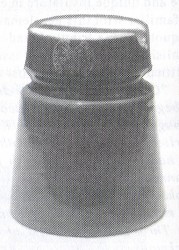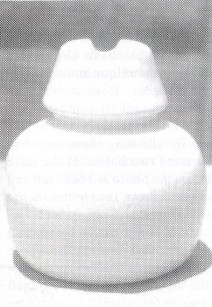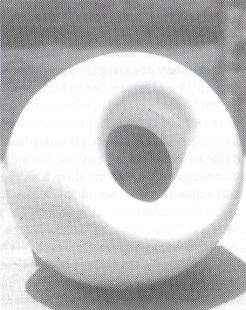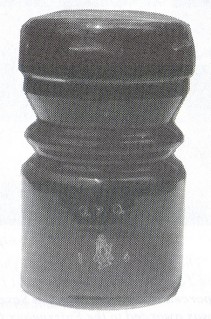Foreign Insulators
by Marilyn Albers
Reprinted from "Crown Jewels of the Wire", February 1998, page 15
UNPUBLISHED PHOTOS FROM
THE W. KEITH NEAL COLLECTION
The collection of W. Keith Neal of Guernsey, Channel Islands, gathered
together over many years time, included some of the most rare and unique
insulators in existence. For those of you who may be unfamiliar with this
gentleman and his love of insulators, I am going to quote from a tribute I made
to him soon after his death, which was published in the July 1990 issue of Crown
Jewels of the Wire. It was entitled "The Hobby has lost a hero".
"On April 11, 1990, the day before Carol McDougald and I were to begin our
month long 'research trip' to Europe, a long distance call brought some sad
news: W. Keith Neal had passed away a few hours earlier. He was 84. His death
came as a shock, even though we knew he had been in poor health for the past
several months. We had planned to stop at his home in Guernsey for a short visit
and he had looked forward so much to our coming. But it was not to be. We will
all miss him - his contributions to the hobby were many.
Through the kindness of
a fellow subscriber, David Hibbert of Rickmansworth, in Herts, England, who sent
copies of obituaries taken from his local newspapers, I am able to give you some
background information about Mr. Neal.
A Baptist minister's son, William Keith
Neal was born at Boxmoor, Hertfordshire in England on November 11, 1905. The
family's home was within sight of the London and North Western Railway and by
the time he was 5 years old, Keith was an enthusiastic 'engine spotter '. This
eventually fired an interest in steam railways, and in particular the ceramic
insulators on the telegraph poles that ran alongside the tracks. He found his
first real treasure, a broken Langdon terminal insulator, at age 8, while
digging around at the bottom of a pole. He searched for and found all the
pieces, glued it back together, and at that moment became an insulator
collector. During the next 76 years, up to the day he died, Keith continued to
add to his collection until he had what he himself acclaimed to be 'the only
really comprehensive collection of almost every known pattern and variety of
ceramic
insulator used over a long period on British Railways '.
Keith was the author
of the books 'SEARCHING FOR RAILWAY TELEGRAPH INSULATORS' (1982) and 'RAILWAY
AND OTHER RARE INSULATORS' (1987), which have been well received by collectors
in the U.S.A. and Canada, as well as in other parts of the world."
He had
been working on a third volume including photos of insulators he had acquired
since 1987, but it was neither finished nor published due to his declining
health. I know he would be pleased that these few examples are being shared with
Crown Jewels of the Wire readers.

One of Keith's favorites.
The profile of this insulator is almost identical to a U-1673 with its height
of 3-1/4", and even though the base diameter is 3/16" less than the 2-7/8" shown. in the WORLDWIDE PORCELAIN INSULATORS book, I suspect it will
qualify as a U-1673. Except for the very top of the crown, which remains white,
the insulator is glazed in a pretty olive green, both inside and out. The pin
hole is just 1/2" in diameter and has tiny threads, intended to screw on to a
metal pin. A 1953 Bullers trademark with "MADE IN ENGLAND" is stamped
in white ink on one side of the crown. Though it is not particularly old, Keith
really liked this little insulator. It was one of the last ones he acquired
before his death.
The insulator you see next has a very unusual profile. It
has been classified as U-1553. The flat top is unglazed but the rest of the
insulator is covered in a rich chocolate brown glaze, inside and out. Like the
U-1673 above, this piece has a 1/2" pin hole with tiny threads for screwing
on to a metal pin. A Bullers trademark dated 1953 is stamped in white ink on one
side of the crown. Keith tied one of his personalized tags around the neck of
the insulator and wrote the following: "Porcelain insulator with one wide
groove and two minor grooves - found in Bullers factory in Stoke-on-Trent".
To my knowledge it is the only example known and he seemed to think it might
have been an experimental piece which was never made in quantity for service on
the lines.

An experimental piece?
The photo below shows two views of a unique one piece oil insulator
classified as U-2903. It is 4" in height and has a girth of 4-3/8" at
the widest part. Designed and patented by Johnson & Phillips of England, it
was first produced by Schomburg & Sohne in Margarethenhutte, Germany some
time during the early 1900' s. Notice how the base of the insulator curls up to
form the oil cup. The only two examples of this style were found by British
collector Dominic Allen several years ago. The insulators were out of service
but high up on a building near London and black as coal! He never explained how he got them down! One he kept for
himself and the other he gave to his friend Keith, who treasured it just as it
was. I have that one in my collection now but I have since cleaned off the soot.
Believe me, it took some doing!!
 |
 |
|
Johnson & Phillips Patent |

Two designs of Walker's double cone insulator.
Neither of these two double cone insulators have U-numbers because they are
not pin types, but they are truly unique and certainly served the purpose for
which they were made. Both styles were patented by Mr. C. V. Walker for use in
damp tunnels and date back to the 1870' s. These insulators made it possible to
carry bare eight-gauge iron wires through damp tunnels by allowing them only one
point of contact right at the center where the two halves of the cone came
together. The one shown on the left in the photo is 3-5/8" tall and was
known as the "standard" type. The example on the right with the open
slot down the side is 1/8" shorter (no significance) and was called a
"replacement" insulator because it could easily be slipped over the
wire when replacing a broken cone, thus leaving the whole line intact. Keith's
first book included a photo of Walker's replacement insulator, and at that time
it was the only one he had. He longed to have one of the standard types and
finally found one. It was to be shown in his third book but it was too late - he
was too ill to carry on with it.

"Wow, a U-1941 with a brown glaze!"
All the U-1941's I've ever seen have had a white glaze, but this particular
example of U1-941 is most unusual because the glaze is a dark chocolate brown.
Only the base and the 1/2" pin hole are left unglazed. This style was used
as a fuse insulator and nicknamed the "pothead". It is 4-5/8" in
height and has a base diameter of 2- 7/8". Stamped in white ink on one side
of the skirt are the letters G.P.O. for "General Post Office". Below
that is the trademark of WADE POTTERIES LTD. located in Portadown, Co. Armagh,
in Northern Ireland, where the insulator was produced. This trademark shows an
owl and a triangle held in the palm of a hand. Keith acquired this beauty on the
Island of Guernsey, Channel Islands, where he made his home soon after
retirement. His housekeeper knew of his passion for insulators and got her
husband to take this particular one down from the side of an abandoned building
so she could present it as a gift to "Mr. Neal", as she politely
referred to him. He wasn't entirely impressed because it was rather a common
style, brown glaze or not, but he thanked her profusely. A few months later I
made a third visit to see Keith and his wife Jane. While there I made shadow
profiles of all his latest acquisitions to include in the WORLDWIDE PORCELAIN
INSULATORS, 1986 SUPPLEMENT. Just as I was leaving for the airport to fly home,
Keith put the brown U-1941 in my hands and said "enjoy it". I was
totally blown away because I thought that insulator was so unusual and so
beautiful - and I guess he knew it. It was my turn to thank him profusely!
The
four insulators you see on the next page were a special part of Keith's
collection, but I have no idea when, how or where he found them. They may have
been gifts from friends traveling through other countries. All are glazed white
with the trademark "Defuisseaux Baudour" stamped in red ink on the
skirts. Quoting from an article I wrote in the January 1991 issue of Crown
Jewels of the Wire magazine,
"The first factory was established in (the city of) Baudour, Belgium in
1842 by an engineer named Francois Declercq, who had studied porcelain
manufacturing in Saxony, Germany. In 1880 the company was awarded to the
Fuissueaux family by the French government for having produced 270,000 porcelain
insulators! Insulators were marked simply "Defuisseaux Baudour". There
were many different owners of the company between 1880 and 1977 when the French
government of this area of Belgium invited NGK (of Japan) to join Baudour."

A magnificent lineup.
The present company name is NGK BAUDOUR S.A. and their trademark is an
artist's conception of a rocket launching pad representing NGK's efforts to
launch new ideas into the world in three areas: ceramic ecology, energy
distribution, and special chemical machines to reduce garbage.
At this time none
of the four insulators has been assigned U-numbers, but that will happen. The
first one on the left in the photo is similar to a U-1595 but is a bit larger.
The next piece to the right won't be assigned a U-number at all because it's
merely an insert for a porcelain insulator. The insulator second from the right
is similar to a U-1364 but is wider and taller and has no inner skirt. The last
one on the far right is similar to a U-1363 but is also without an inner skirt
and doesn't quite fit the profile.
With the help of Elton Gish, my goal for 1998
is to update the WORLDWIDE PORCELAIN INSULATORS books, and consolidate all of
the material, the old and the new, into one book. If Keith Neal were with us
today, he would still be contributing to this effort. The hobby has indeed lost
a hero.
| 